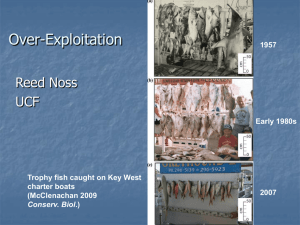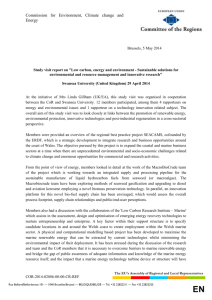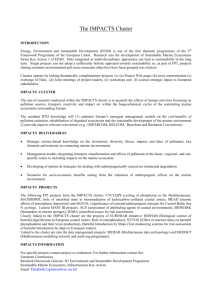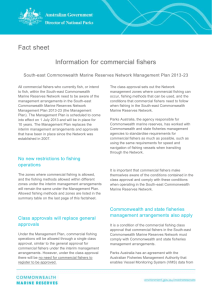Economic impacts of marine reserves: the
advertisement
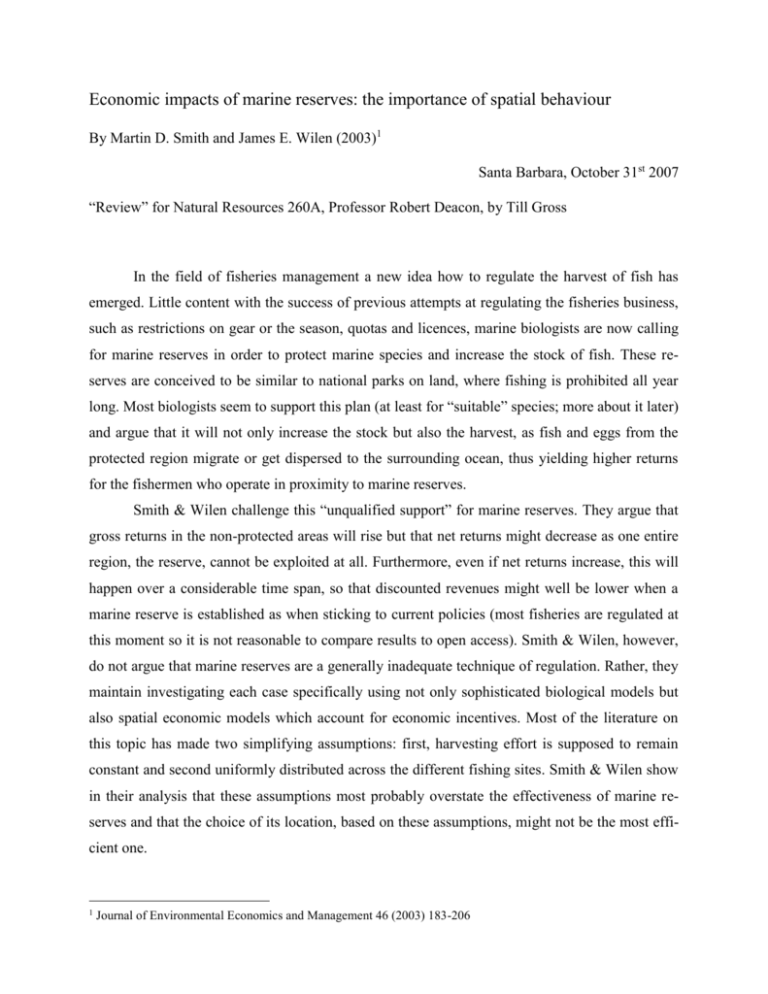
Economic impacts of marine reserves: the importance of spatial behaviour By Martin D. Smith and James E. Wilen (2003)1 Santa Barbara, October 31st 2007 “Review” for Natural Resources 260A, Professor Robert Deacon, by Till Gross In the field of fisheries management a new idea how to regulate the harvest of fish has emerged. Little content with the success of previous attempts at regulating the fisheries business, such as restrictions on gear or the season, quotas and licences, marine biologists are now calling for marine reserves in order to protect marine species and increase the stock of fish. These reserves are conceived to be similar to national parks on land, where fishing is prohibited all year long. Most biologists seem to support this plan (at least for “suitable” species; more about it later) and argue that it will not only increase the stock but also the harvest, as fish and eggs from the protected region migrate or get dispersed to the surrounding ocean, thus yielding higher returns for the fishermen who operate in proximity to marine reserves. Smith & Wilen challenge this “unqualified support” for marine reserves. They argue that gross returns in the non-protected areas will rise but that net returns might decrease as one entire region, the reserve, cannot be exploited at all. Furthermore, even if net returns increase, this will happen over a considerable time span, so that discounted revenues might well be lower when a marine reserve is established as when sticking to current policies (most fisheries are regulated at this moment so it is not reasonable to compare results to open access). Smith & Wilen, however, do not argue that marine reserves are a generally inadequate technique of regulation. Rather, they maintain investigating each case specifically using not only sophisticated biological models but also spatial economic models which account for economic incentives. Most of the literature on this topic has made two simplifying assumptions: first, harvesting effort is supposed to remain constant and second uniformly distributed across the different fishing sites. Smith & Wilen show in their analysis that these assumptions most probably overstate the effectiveness of marine reserves and that the choice of its location, based on these assumptions, might not be the most efficient one. 1 Journal of Environmental Economics and Management 46 (2003) 183-206 2 Other economists had already investigated the effect of adjusting harvesting effort to incentives and explored whether marine reserves yield higher returns in a dynamic model which discounts future profits and thus places a higher weight on present returns. The main contribution of this paper, however, is to show the importance of spatial behaviour on whether and where a marine reserve should be established. For example, “little marine reserves” might evolve in an equilibrium just by the fact that such an area is difficult to access and harvest with subsequent spillover-effects of fish and larvae. To investigate this, Smith & Wilen do a case study in which they explore by econometric analysis the possible effects of reserves on the red sea urchin fishery in California. The choice supports their hypotheses as the red sea urchin lends well for a reserve, since it is “suitable”: - The fish have a low mobility and stick generally to their habitat, a necessary condition for the success of a marine reserve, as otherwise migrating fish could easily be caught in the surrounding waters by luring fishermen. - Larvae on the other hand are fairly mobile, thus creating spill-over effects, increasing the stock in adjacent areas. - Maybe most importantly, bigger (older) red sea urchins produce proportionately higher amounts of eggs than smaller (younger) ones, creating increasing returns to scale. The results should therefore generalize to less “suitable” species, too. Further reasons for their choice is the ready availability of huge amounts of data on harvester behaviour, oceanographic and meteorological conditions as well as the red sea urchin itself. Additionally, the divers, who stay by and large the same people, show sufficiently large variation in their choice of fishing spots, reacting to different conditions such as distance from ports, expected revenues, weather conditions etc. Smith & Wilen use a Repeated Nested Logit (RNL) for their estimation, a technique employed by other researchers on similar studies, which seems well suited for their intent. Overall, their study appears to be thoroughly carried out with sufficient and reliable data, rendering it quite credible. The economic reasoning with which the authors explain und underpin their findings is very convincing. However, a few points, mainly regarding their estimation procedure, remain a little obscure or deserve further explanation and justification. Smith & Wilen state dryly that “The drawbacks of RNL are equally well known and include assumptions of independence across both time and in- 3 dividuals.”2, without further discussion whether these assumptions are warranted or not. This is definitely a drawback, especially as they mention “control variables” that are harvester- & timespecific and choice-specific but do not elaborate what they are. The question thus arises, how the reader is supposed to judge whether the assumption of independent identically distributed error terms is warranted or not. For example, if we suspect that herd behaviour might be prevalent among the divers (above following same weather conditions etc.), then the independence assumption is certainly difficult to uphold. But again, it is hard to make any judgments as the authors do not supply the reader with enough information. Another assumption, the linearity of the utility function, might require further inquiry. Results could possibly change by a large amount if, say, harvester characteristics and choice statistics were intertwined. For example, if some divers had a comparative advantage in operating at certain environments/ spots, then the spatial results could change. Also, without linearity, and assuming some sort of insurance were obtainable, agents would most probably not take binary decisions but randomise their behaviour, so as to equalize marginal expected utilities instead of choosing the option that yields the highest anticipated payoff. Admittedly, this would render the model a lot more complicated and it might be reasonable to drop the whole issue for the sake of reducing complexity but it could be addressed all the same. An explanation concerning the robustness of the results concerning a non-linear utility function would, in my opinion, add to the paper’s credibility. The same could be said about supposing a logarithmic distribution function. Why should it be suited to this model and not a normal distribution? No mention of this choice is made nor are any reasons for it given. A problem that may arise is that if the distributional assumptions do not match the data, the estimators are inconsistent. A linear probability model may produce negative probabilities or ones that are greater than one but does not produce inconsistent results. This is not to say that the linear model is better but the reader would probably like to see a justification. One bizarre – though only secondary – result of the paper is that egg production forecasts in the economic model are two to three times higher than in the simulated models which do not account for differing spatial behaviour. One explanation could be that uniformly distributed fishing effort has to lead to lower steady state levels of larvae than a spatially divergent one, when there are increasing returns to scale. However, the steady state levels of harvest are very close in both models, which strikes the reader as odd, given that so many more eggs are lain off. This discrep2 Footnote number 18 on page 191. 4 ancy is not explained in the paper, leaving the observer alone to figure out this conundrum on his own. Is there a good reason for it or does it indicate a fallacy of the model? Finally, the specific structure of the red sea urchin fishery in Southern California could possibly have led to the results in the paper. For example, there are only four major ports which account for more than 80 % of all the catch’s intake. Considering the impact the distance to ports has in the econometric analysis, one could be led to think that a more widely distributed fishing industry would result in a distribution of harvesting effort that is almost uniform. This would be congruent to the biologists’ assumptions and reduce greatly the impact of economic spatial behaviour. A similar effect might be produced by “patchy” behaviour of the fishermen, i.e. that they mainly stay in their known area and do not change fishing spots frequently when incentives change. This fact might depend on the technology the fishermen are using. Further research in this area should probably focus on the evaluation of other proposed implementations of marine reserves, testing whether they would increase net discounted yield at all and if yes, where best to create these reserves. Addressing the issues of this paper mentioned above in such studies would also shed further light on the accuracy of Smith & Wilen’s paper. It seems doubtful that the results would differ after changes in the estimation technique but showing that the findings are robust to altered assumptions would improve this article’s credibility.
